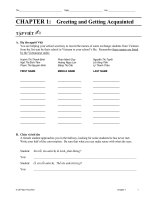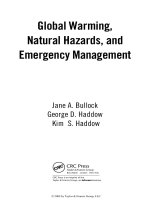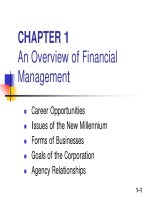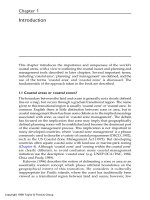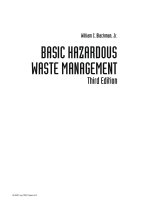Opration management chapter 1 operation and productivity
Bạn đang xem bản rút gọn của tài liệu. Xem và tải ngay bản đầy đủ của tài liệu tại đây (621.54 KB, 48 trang )
Operations
Management
Session 1 –
Operations and
Productivity
© 2008 Prentice Hall, Inc.
1–1
Learning Objectives
When you complete this chapter
you should be able to:
1. Define operations management
2. Explain the distinction between
goods and services
3. Explain the difference between
production and productivity
© 2008 Prentice Hall, Inc.
1–2
Learning Objectives
When you complete this chapter
you should be able to:
4. Compute single-factor
productivity
5. Compute multifactor productivity
6. Identify the critical variables in
enhancing productivity
© 2008 Prentice Hall, Inc.
1–3
What Is Operations
Management?
Production is the creation of
goods and services
Operations management (OM)
is the set of activities that
creates value in the form of
goods and services by
transforming inputs into
outputs
© 2008 Prentice Hall, Inc.
1–4
Organizing to Produce
Goods and Services
Essential functions:
Marketing – generates demand
Production/operations – creates
the product
Finance/accounting – tracks how
well the organization is doing, pays
bills, collects the money
© 2008 Prentice Hall, Inc.
1–5
Why Study OM?
OM is one of three major functions
(marketing, finance, and operations)
of any organization
We want (and need) to know how
goods and services are produced
We want to understand what
operations managers do
OM is such a costly part of an
organization
© 2008 Prentice Hall, Inc.
1–6
What Operations
Managers Do
Basic Management Functions
Planning
Organizing
Staffing
Leading
Controlling
© 2008 Prentice Hall, Inc.
1–7
The Critical Decisions
Design of goods and services
What good or service should we
offer?
How should we design these products
and services?
Managing quality
How do we define quality?
Who is responsible for quality?
Table 1.2 (cont.)
© 2008 Prentice Hall, Inc.
1–8
The Critical Decisions
Process and capacity design
What process and what capacity will
these products require?
What equipment and technology is
necessary for these processes?
Location strategy
Where should we put the facility?
On what criteria should we base the
location decision?
Table 1.2 (cont.)
© 2008 Prentice Hall, Inc.
1–9
The Critical Decisions
Layout strategy
How should we arrange the facility?
How large must the facility be to meet
our plan?
Human resources and job design
How do we provide a reasonable work
environment?
How much can we expect our
employees to produce?
Table 1.2 (cont.)
© 2008 Prentice Hall, Inc.
1 – 10
The Critical Decisions
Supply chain management
Should we make or buy this component?
Who are our suppliers and who can
integrate into our e-commerce program?
Inventory, material requirements
planning, and JIT
How much inventory of each item should
we have?
When do we re-order?
Table 1.2 (cont.)
© 2008 Prentice Hall, Inc.
1 – 11
The Critical Decisions
Intermediate and short–term
scheduling
Are we better off keeping people on
the payroll during slowdowns?
Which jobs do we perform next?
Maintenance
Who is responsible for maintenance?
When do we do maintenance?
Table 1.2 (cont.)
© 2008 Prentice Hall, Inc.
1 – 12
Where are the OM Jobs?
© 2008 Prentice Hall, Inc.
Technology/methods
Facilities/space utilization
Strategic issues
Response time
People/team development
Customer service
Quality
Cost reduction
Inventory reduction
Productivity improvement
1 – 13
The Heritage of OM
Division of labor (Adam Smith 1776;
Charles Babbage 1852)
Standardized parts (Whitney 1800)
Scientific Management (Taylor 1881)
Coordinated assembly line (Ford/
Sorenson 1913)
Gantt charts (Gantt 1916)
Motion study (Frank and Lillian Gilbreth
1922)
Quality control (Shewhart 1924; Deming
1950)
© 2008 Prentice Hall, Inc.
1 – 14
The Heritage of OM
Computer (Atanasoff 1938)
CPM/PERT (DuPont 1957)
Material requirements planning (Orlicky
1960)
Computer aided design (CAD 1970)
Flexible manufacturing system (FMS 1975)
Baldrige Quality Awards (1980)
Computer integrated manufacturing (1990)
Globalization (1992)
Internet (1995)
© 2008 Prentice Hall, Inc.
1 – 15
Taylor’s Principles
Management Should Take More
Responsibility for:
Matching employees to right job
Providing the proper training
Providing proper work methods and
tools
Establishing legitimate incentives for
work to be accomplished
© 2008 Prentice Hall, Inc.
1 – 16
Henry Ford
Born 1863; died 1947
In 1903, created Ford Motor
Company
In 1913, first used moving assembly
line to make Model T
Unfinished product moved by
conveyor past work station
Paid workers very well for 1911
($5/day!)
© 2008 Prentice Hall, Inc.
1 – 17
W. Edwards Deming
Born 1900; died 1993
Engineer and physicist
Credited with teaching Japan
quality control methods in postWW2
Used statistics to analyze process
His methods involve workers in
decisions
© 2008 Prentice Hall, Inc.
1 – 18
Contributions From
Human factors
Industrial engineering
Management science
Biological science
Physical sciences
Information technology
© 2008 Prentice Hall, Inc.
1 – 19
New Challenges in OM
From
To
Local or national focus
Batch shipments
Global focus
Just-in-time
Low bid purchasing
Supply chain
partnering
Rapid product
development,
alliances
Mass
customization
Empowered
employees, teams
Lengthy product
development
Standard products
Job specialization
© 2008 Prentice Hall, Inc.
1 – 20
Characteristics of Goods
Tangible product
Consistent product
definition
Production usually
separate from
consumption
Can be inventoried
Low customer
interaction
© 2008 Prentice Hall, Inc.
1 – 21
Characteristics of Service
Intangible product
Produced and
consumed at same time
Often unique
High customer
interaction
Inconsistent product
definition
Often knowledge-based
Frequently dispersed
© 2008 Prentice Hall, Inc.
1 – 22
Industry and Services as
Percentage of GDP
90 −
Services
80 −
Manufacturing
70 −
60 −
50 −
40 −
30 −
20 −
© 2008 Prentice Hall, Inc.
US
UK
Spain
South Africa
Russian Fed
Mexico
Japan
Hong Kong
Germany
France
Czech Rep
China
Canada
0−
Australia
10 −
1 – 23
Goods Versus Services
Attributes of Goods
(Tangible Product)
Attributes of Services
(Intangible Product)
Can be resold
Can be inventoried
Some aspects of quality
measurable
Selling is distinct from
production
Product is transportable
Reselling unusual
Difficult to inventory
Quality difficult to measure
Site of facility important for cost
Often easy to automate
Revenue generated primarily
from tangible product
© 2008 Prentice Hall, Inc.
Selling is part of service
Provider, not product, is
often transportable
Site of facility important for
customer contact
Often difficult to automate
Revenue generated primarily
from the intangible service
Table 1.3
1 – 24
Goods and Services
Automobile
Computer
Installed carpeting
Fast-food meal
Restaurant meal/auto repair
Hospital care
Advertising agency/
investment management
Consulting service/
teaching
Counseling
100%
|
75
|
50
|
25
|
0
|
25
|
50
|
75
|
100%
|
Percent of Product that is a Good Percent of Product that is a Service
Figure 1.4
© 2008 Prentice Hall, Inc.
1 – 25

